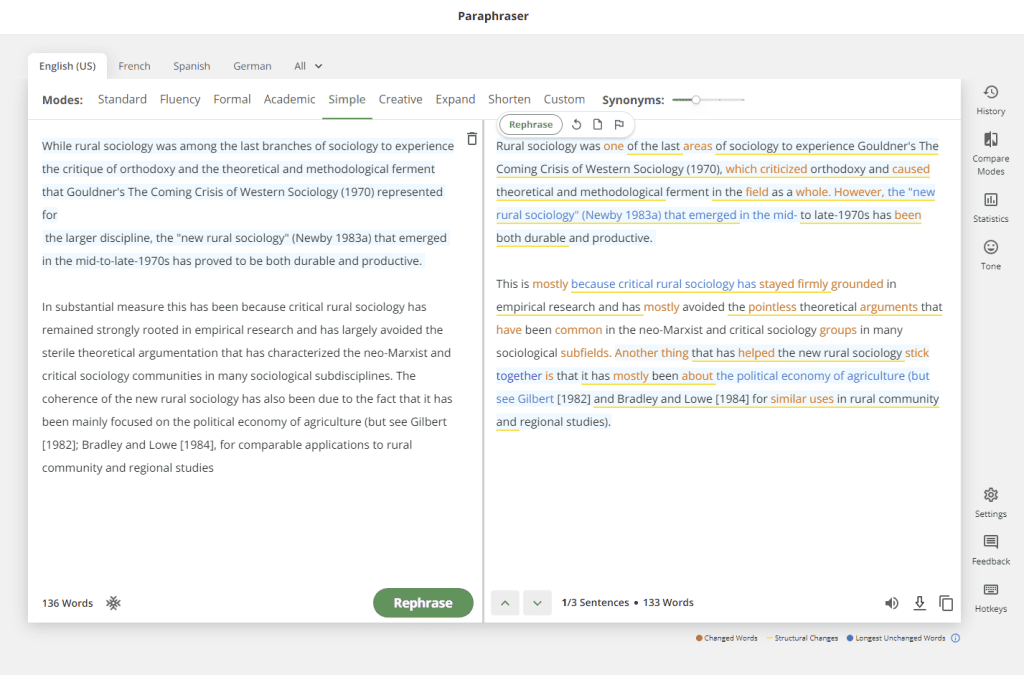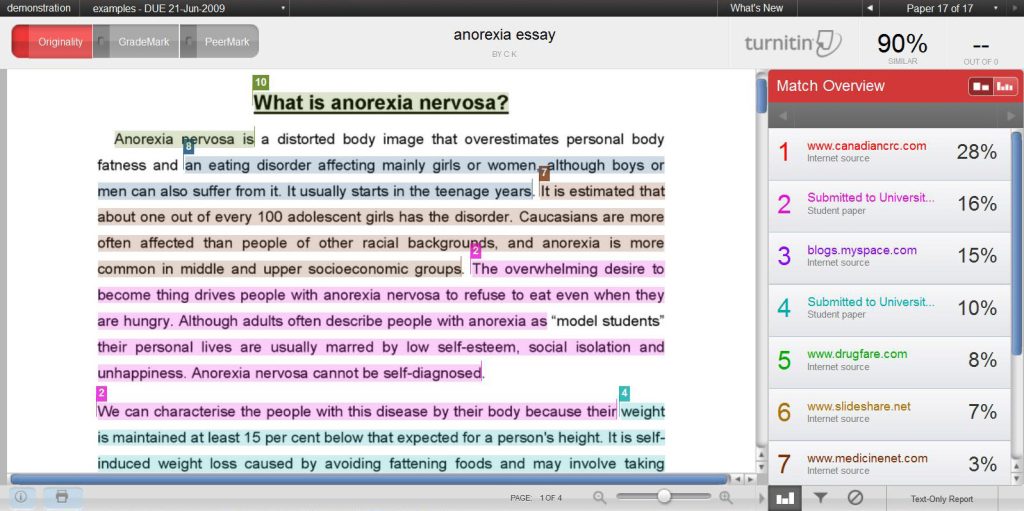In the field of online learning, Turnitin and Quillbot perform different functions. Turnitin is a web-based plagiarism detection and prevention system largely used by educational institutions. In contrast, Quillbot is an online application that uses artificial intelligence to rewrite information, with the goal of improving writing by providing paraphrase services.
There has been some debate over Turnitin’s capacity to detect information paraphrased using Quillbot. Turnitin initially struggled to recognize information that Quillbot had paraphrased due to Quillbot’s ability to change the order of sentences and paragraphs and replace words with synonyms, rendering plagiarism checks useless. This is because Turnitin and other comparable plagiarism checkers detect similar linguistic patterns, phrases, and sentence structures rather than paraphrases per se.
Turnitin’s technology, on the other hand, appears to have improved over time, potentially allowing it to recognize distinctive patterns utilized by QuillBot. According to our testing, Turnitin’s improved algorithms can now recognize and label the characteristic patterns and structures seen in AI-generated material, such as Quillbot’s. We already know that Turnitin can successfully detect ChatGPT content with ease, most of the time.

These results suggest that, while Quillbot was initially capable of avoiding Turnitin’s plagiarism detection, advances in Turnitin’s algorithms may have limited Quillbot’s effectiveness in this regard. Nonetheless, the accuracy with which Turnitin can identify QuillBot paraphrased information may vary, and users should verify any paraphrased content before submission to avoid plagiarism difficulties.
What is Turnitin and how does it work?
Turnitin is an innovative plagiarism-checking technology that is at the vanguard of academic integrity. Its proprietary algorithms look for similarities in language patterns, words, and sentence structures in student submissions, finding potential examples of plagiarism.
Turnitin’s upgraded detection systems may catch even subtle efforts at paraphrasing, not simply word-for-word matches. As part of its commitment to uphold academic honesty across universities worldwide, the program then generates a detailed report detailing possible instances of intellectual property theft or mimicry.
What is QuillBot, and how does it work?
Quillbot, a brilliant tool, takes center stage regarding content alteration. Quillbot, like Turnitin, is designed with cutting-edge AI, but it serves a completely different purpose: effectively and quickly paraphrasing written text.
The algorithms analyze the source text for appropriate synonyms for words while keeping semantic coherence. This can be used to add nuance to your writing or to revise entire articles in seconds! But here’s where it gets interesting: Turnitin’s detection technology misses Quillbot’s sophisticated linguistic rephrasing! So, future writers and students may want to have a look at this undetected paraphrasing device.

Turnitin’s AI Detection Technology
Turnitin has launched iThenticate 2.0, an AI detection-powered tool, to assist maintain the integrity of high-stakes content by separating AI-written material from human-written text, a skill honed over 25 years of experience, particularly in the context of student writing. This artificial intelligence detection tool has been widely adopted, with 98% of Turnitin’s customers enabling it, and it has independently proved a high level of accuracy in recognizing AI-generated work, notably in the field of student writing.
The technology is designed to assist educators in identifying texts that generative AI tools may have generated, but it should not be used as the sole basis for adverse actions against a student due to possible inaccuracies in distinguishing between human and AI-generated text.
Due to the comparable writing characteristics across various model versions, Turnitin’s AI writing detection model is now trained to detect text generated by GPT-3/GPT-3.5, and GPT-4 language models, including ChatGPT and ChatGPT Plus.
How Turnitin detects paraphrasing and similarities in a document
Turnitin’s advanced AI technology is designed to identify paraphrasing and similarities in any piece of writing. It combs through a sea of data, aggressively scanning documents for distinctive patterns that might indicate potential plagiarism or duplication.

These exact algorithms go beyond simple text matching, looking into phrase structure and context, focusing on linguistic and stylistic components.
Another significant layer in Turnitin’s detection prowess comes from its collaboration with OpenAI. Their ChatGPT detector presents an additional defense against cleverly concealed plagiarized content by flagging articles written using QuillBot paraphrasing techniques.
This sophisticated AI writing detector has quickly gained popularity among educators, with over 2.1 million teachers employing it as their ally in the battle against plagiaristic attempts within academic writing.
Turnitin’s technological growth reveals not just breakthroughs in AI-driven plagiarism detection, but also how this tool can keep one step ahead of intelligent paraphrase technologies like Quillbot or Chat GPT.
OpenAI collaboration and potential impact on detection accuracy
Turnitin is harnessing the power of AI for its detection technology through a collaboration with OpenAI. This groundbreaking partnership aims to improve content recognition and enhance Turnitin’s accuracy in identifying AI-generated material, including that from platforms like ChatGPT.
With this advancement, Turnitin claims 98% accuracy in distinguishing between human-created and machine-written prose.
This involvement with OpenAI has changed the game for Turnitin by significantly reducing false positives. The goal is to identify paraphrasing or improper copying more efficiently without flagging genuinely original academic writing as potentially suspicious.
A stronger detection system will certainly raise obstacles for technologies like QuillBot that utilize sophisticated techniques for rephrasing content.
How QuillBot Can Beat Turnitin’s Detection
QuillBot uses AI to paraphrase text by changing the order of lines and paragraphs and replacing words with their equivalents. This can make the text look unique and different from the original.
Turnitin’s detection algorithms are mostly made to find similarities based on grammar patterns, phrases, and sentence structures. This type of restructuring and rewording makes it hard for Turnitin to tell that the content that has been paraphrased is not original.
Additionally, QuillBot’s paraphrasing feature doesn’t just change a few words; it rewrites whole sentences. This makes the final text look like original content to Turnitin and other plagiarism checkers programmed to cut texts into small pieces and compare them with different sources to see how similar they are.
Advantages of using Quillbot for paraphrasing
When you need to paraphrase, Quillbot can help you in a lot of ways. Here’s how:
- Turnitin usually has trouble finding unique ways of copying, but Quillbot does. This sneaky trait makes it more likely that the plagiarism software won’t catch you.
- A complex algorithm was used to create the tool. It changes more than just the words; it rearranges whole lines, which makes it harder for tools like Turnitin to find.
- Because Quillbot is so flexible, you can be creative with your writing without changing the sense of the original text.
- Utilizing Quillbot is a useful way to learn because it teaches you how to make up your own sentences and phrases.
- Using this tool makes it easy to avoid plagiarism. It facilitates the creation of really original content that is free of any evidence of plagiarism.
- Quillbot’s technology is always improving, allowing it to stay one step ahead of Turnitin’s growing detection tactics.
Tips for using Quillbot to evade Turnitin’s detection
There are some good ways to use Quillbot to avoid being caught by Turnitin.
- Don’t use Quillbot too much in every line. Change only the parts that you find hard or where you need more complex words.
- Look over and fix the results that Quillbot gave you. It changes words and statements, which may not always make sense in the right situation.
- Add your own style to the words that you have changed. This helps hide any obvious signs that you used a paraphrase tool.
- Don’t depend on Quillbot to do all of your work; use it to improve your writing skills, not replace them.
- To make sure your work is original and to stop Turnitin’s powerful plagiarism tool from finding patterns, use separate sentences.
- Do the right thing and use Quillbot properly; don’t copy other people’s work, but use it to improve your own thoughts in your own words.
In the end, both Turnitin and Quillbot are useful in education. However, over time, Turnitin has become better at finding Quillbot’s copying methods. Even though Quillbot can help with summarizing, users should be careful not to plagiarize. In this ongoing fight between technology and creativity, both tools keep getting better.





